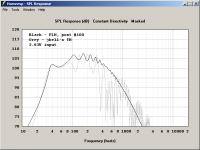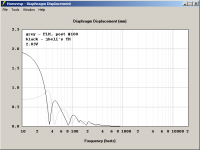according to the sim, it seems that the folded horn specs i came up limit the cone excursion alot more compared to the tapped horn.
the tapped horn runs out of xmax at 40hz and 40V
the frontloaded at 65hz and 60V, which gives it +5db of extra max spl.
now let's fire up autocad and see if i can come up with something easy enough to built 🙂 i want to built this, measure it and compare with the th, which is already very impressive on kick drum.
i wanted to edit my previous post but the button is gone, is there a time limit to that ?
the tapped horn runs out of xmax at 40hz and 40V
the frontloaded at 65hz and 60V, which gives it +5db of extra max spl.
now let's fire up autocad and see if i can come up with something easy enough to built 🙂 i want to built this, measure it and compare with the th, which is already very impressive on kick drum.
i wanted to edit my previous post but the button is gone, is there a time limit to that ?
"It'd be a REALLY INTERESTING topic to find the answer to... Why is a TH directional? "
Any numbers on how directional it is?
What frequency, how wide...
Any numbers on how directional it is?
What frequency, how wide...
My guess: phase based. Where the rear wavefront from the horn meets the front wavefront from the driver causes a lobe or bubble pointing the resultant. It takes two signals to steer, so I'm guessing interaction between front of the driver with the rear.
Outside would be great! Assuming you use the 3015LF from the Omni15, all cabs are loaded with the same speaker, so it's going to be a pretty fair comparison.
This weekend is a bit busy for me, but can we do it next weekend, let's say saturday afternoon?
28V, Paul, how close are your neighbours, 'cause that's gonna be loud 😱😀.
Looking at the charts, I expect that too, jbell. I am thinking about measuring methods now. The only thing I have that is calibrated for SPL, is my Behringer DEQ2496 with the ECM8000 measurement mic. But I have various options for measuring (relative) frequency curves. Of course I can measure 100Hz on the DEQ2496 and then adjust the mic preamp for the same level in SMAART or something 🙄.
What's the best place to put the mic? I'm thinking ground plain or 1 inch from the ground...
This testing ever happen? I'm interested to know how they compared.
I also ran across another little bit of info related to this, seems BF has a comment on how the 'sound' should differ, one to the other, so a subjective listening test would probably be appropriate as well.
BillFitzmaurice.net - View topic - OT112/212 vs JTR Triple 12
not yet, bad luck with the weather here, too much rain and wind.
it's still storming out here as i'm typing this.
got a behringer dcx2486 for crossing over btw, time to give that tapped horn a good testdrive 🙂
it's still storming out here as i'm typing this.
got a behringer dcx2486 for crossing over btw, time to give that tapped horn a good testdrive 🙂
Last edited:
not yet, bad luck with the weather here, too much rain and wind.
it's still storming out here as i'm typing this.
got a behringer dcx2486 for crossing over btw, time to give that tapped horn a good testdrive 🙂
LR48@38hz HP, LR24@90hzLP would be a good place to start. (90hz LP just shaves a little off of the 100hz bump in response, and gives you a nice flat response from 40-100, with a couple db bump up at 40... that whole equal-loudness curve thing...)
have fun
Last edited:
If I understand your comment about slopes correctly -- slopes are same. 48db butterworth is same slope as 48db LR.
However, LR is flat at crossover freq, butterworth has a 3db bump as davy's chart shows.
I really don't like the sound, even spaced apart to eliminate some bump of the butterworth slopes in the dcx2496. (aka, 90hz24but LP sub and 120hz24but HP top doesn't sound as good to me as even 100hz24LR LP sub and 100hz 24LR HP top) Now, I could just be crazy on this one.. but I don't use the butterworth slopes for any reason on a dcx.
For a good place to start, I'd set sub at 90hzLR24 LP (only because there is a slight bump at 100hz for the TH) and top at 100hzLR24 HP. That should give you a really nice transition. (at least it did for me)
However, LR is flat at crossover freq, butterworth has a 3db bump as davy's chart shows.
I really don't like the sound, even spaced apart to eliminate some bump of the butterworth slopes in the dcx2496. (aka, 90hz24but LP sub and 120hz24but HP top doesn't sound as good to me as even 100hz24LR LP sub and 100hz 24LR HP top) Now, I could just be crazy on this one.. but I don't use the butterworth slopes for any reason on a dcx.
For a good place to start, I'd set sub at 90hzLR24 LP (only because there is a slight bump at 100hz for the TH) and top at 100hzLR24 HP. That should give you a really nice transition. (at least it did for me)
"It'd be a REALLY INTERESTING topic to find the answer to... Why is a TH directional? "
Any numbers on how directional it is?
What frequency, how wide...
I don't think TH is directional at bass frequencies other than a big baffle restricting radiation to half-space (ie. baffle step). The radiating area is just too small for the wavelengths involved.
I don't think TH is directional at bass frequencies other than a big baffle restricting radiation to half-space (ie. baffle step). The radiating area is just too small for the wavelengths involved.
what measurements do you have to support this thought?
what measurements do you have to support this thought?
I don't have one right now, but just use tape measure to get the dimensions of the mouth 🙂
From http://www.danleysoundlabs.com/pdf/danley_tapped.pdf :
f = K / (d * theta), where d=diameter (in m), theta=coverage angle, K= constant = 2.54*10^4
It gives the frequency where a horn looses directivity control. I think the mouth size required for < 100 Hz becomes very large according to this equation.
Yes, In danley's paper, while discussing the synergy horn, he gives the 'typical' formula for figuring out directivity. (which applies to front loaded horns)
However, Tom has stated many times, that the mouth size and performance of a TH doesn't follow 'typical.' I'm reasonably sure that davy's comment earlier in this thread of the combining of the front/rear waves probably has something to do with a TH's directivity.
I've been taught that bass is ALWAYS omnidirectional, and that the only way to steer bass is to have a very large array outdoors only, where you can use phase/pressure differences to shape the response.
However, should you build one, put it in the middle of a field, turn up a 40hz sine wave, and walk around it -- you will come to a different way of thinking...
I have.
However, Tom has stated many times, that the mouth size and performance of a TH doesn't follow 'typical.' I'm reasonably sure that davy's comment earlier in this thread of the combining of the front/rear waves probably has something to do with a TH's directivity.
I've been taught that bass is ALWAYS omnidirectional, and that the only way to steer bass is to have a very large array outdoors only, where you can use phase/pressure differences to shape the response.
However, should you build one, put it in the middle of a field, turn up a 40hz sine wave, and walk around it -- you will come to a different way of thinking...
I have.
just did some more modelling in hornresp, it seems that this cab would work too with an eminence definemax 4018LF, sensitivity would be about the same but it can take more power before running out of xmax, gets about 2db more output.
any drawbacks to using an 18 inch in this cab ? would the cone get damaged quicker ?
any drawbacks to using an 18 inch in this cab ? would the cone get damaged quicker ?
Compression ratio is still a meager 1.68. Over 2.5 and I'd start to worry. Nice find. I wonder if any other 18s would work, too? L12 and L34 would be a bit longer with an equally shorter L23.
The Electro-Voice EVX-180B is a dud. Runs out of excursion way too early. The Eminence Kilomax Pro 18A has a more peaky sim response in HR. The B&C 18TBX100 looks good.
The Electro-Voice EVX-180B is a dud. Runs out of excursion way too early. The Eminence Kilomax Pro 18A has a more peaky sim response in HR. The B&C 18TBX100 looks good.
don't really know if it's worth it though, while this cab get alot of sensitivity it seems to run out of excursion pretty quick, a frontloaded horn in this size can get the extension and sensitivity too, look at those hornresp inputs i posted earlier, but the excursion would be alot lower, according to my hornresp sims it would get about 3 - 4 db's extra output vs this tapped horn.
you mean post#100? Mouth is 4500cm2 compared to 3000cm2. Excursion looks less in the passband, but the humps are at different spots though for basically the same linear regression. FLH would have to highpass a little higher to escape its peak before the Vrc took over. And yes, the excursion peak in the passband is higher for the TH before the cab resonance which is lower. I don't know, I'm confused.
Attachments
Hmmm... This looks interesting.. Two Peerless SWR308 (830500 XLS) in series with S1=220 and L23=280 takes a silly amount of power before losing to Xmax. I see 562W assuming the drivers are really 5 Ohm.
Last edited:
you mean post#100? Mouth is 4500cm2 compared to 3000cm2. Excursion looks less in the passband, but the humps are at different spots though for basically the same linear regression. FLH would have to highpass a little higher to escape its peak before the Vrc took over. And yes, the excursion peak in the passband is higher for the TH before the cab resonance which is lower. I don't know, I'm confused.
you're right, missed that one..
- Home
- Loudspeakers
- Subwoofers
- jbell's set of four tapped horns


